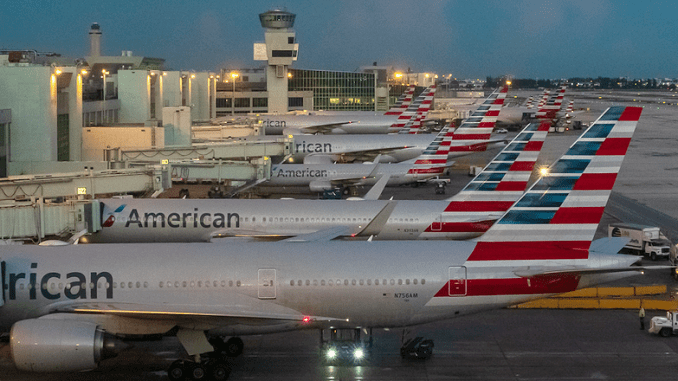
BOSTON, Massachusetts, October 10, 2021 (ENS) – The air transport industry is joining the current global wave of commitments to a climate protection goal of net-zero carbon emissions by 2050. At its annual general meeting in Boston last week, the International Air Transport Association, IATA, approved a resolution adopting this goal, which aligns with the Paris Agreement target to keep climate change to no more than 1.5°Celsius above pre-industrial levels.
IATA represents some 290 airlines that make up 82 percent of global air traffic. The aviation industry must progressively reduce its emissions while accommodating the growing demand of a world that is eager to fly.
“The world’s airlines have taken a momentous decision to ensure that flying is sustainable. The post-COVID-19 re-connect will be on a clear path towards net zero. That will ensure the freedom of future generations to sustainably explore, learn, trade, build markets, appreciate cultures and connect with people the world over,” said IATA Director General Willie Walsh.
Achieving net zero emissions by 2050 will be a huge challenge for these companies, Walsh declared. He says hitting that target will take the collective efforts of the entire value chain plus supportive government policies.
IATA says that all industry stakeholders, including governments, must each take responsibility to address the environmental impact of their own policies, products, and activities and work together to break aviation’s dependance on fossil fuels.
“Achieving sustainable global connectivity cannot be accomplished on the backs of airlines alone. All parts of the aviation industry must work together within a supportive government policy framework to deliver the massive changes that are needed, including an energy transition,” Walsh said. “That is no different than what we are seeing in other industries.”
He wants the same incentives for the airline industry to make the switch from fossil fuels to zero carbon emissions as the automotive industry enjoys.
Walsh points out that, “Road transport sustainability efforts, for example, are not being advanced by drivers building electric vehicles. Governments are providing policies and financial incentives for infrastructure providers, manufacturers and car owners to be able to collectively make the changes needed for a sustainable future. The same should apply to aviation.”
A mix of new technology, including shifting to electricity and hydrogen for some shorter distances; improvements in operations and infrastructure; and a transition to sustainable aviation fuel by mid-century would provide a majority of the carbon reductions. Remaining emissions would be captured using carbon capture and storage.
Net-Zero By 2050 Target Isn’t Perfect
The world has a viable pathway to building a global energy sector with net-zero emissions in 2050, but it is narrow and requires an unprecedented transformation of how energy is produced, transported and used globally, the International Energy Agency said in a landmark special report released in May.
“Climate pledges by governments to date – even if fully achieved – would fall well short of what is required to bring global energy-related carbon dioxide (CO2) emissions to net zero by 2050 and give the world an even chance of limiting the global temperature rise to 1.5 °C, according to the new report, “Net Zero by 2050: a Roadmap for the Global Energy Sector.”
IEA Executive Director Fatih Birol said, “Our Roadmap shows the priority actions that are needed today to ensure the opportunity of net-zero emissions by 2050 – narrow but still achievable – is not lost.”
“The scale and speed of the efforts demanded by this critical and formidable goal – our best chance of tackling climate change and limiting global warming to 1.5 °C – make this perhaps the greatest challenge humankind has ever faced,” said Birol.
The IEA report is designed to inform the high-level negotiations that will take place at the 26th Conference of the Parties (COP26) of the United Nations Climate Change Framework Convention in Glasgow in November. It was requested as input to the negotiations by the UK government’s COP26 Presidency.
COP26 President-Designate Alok Sharma said, “I welcome this report, which sets out a clear roadmap to net-zero emissions and shares many of the priorities we have set as the incoming COP Presidency – that we must act now to scale up clean technologies in all sectors and phase out both coal power and polluting vehicles in the coming decade.”
IATA: ‘We Have a Plan’
IATA’s strategy is to abate as much CO2 as possible from in-sector solutions such as sustainable aviation fuels, supporting new aircraft technologies such as hydrogen and electric, more efficient operations and infrastructure, and the development of new zero-emissions energy sources such as electric and hydrogen power.
“We have a plan,” Walsh said. “The scale of the industry in 2050 will require the mitigation of 1.8 gigatons of carbon. A potential scenario is that 65 percent of this will be abated through sustainable aviation fuels.”
“We would expect new propulsion technology, such as hydrogen, to take care of another 13 percent,” he calculated, “and efficiency improvements will account for a further three percent. The remainder could be dealt with through carbon capture and storage (11 percent) and offsets (8 percent).”
Other air transport sectors are in favor of the new goal. The Airports Council International (ACI-World) issued an immediate statement of support.
“We are thrilled to see the aviation sector united in reaching this goal,” ACI World Director General Luis Felipe de Oliveira said. “ACI member airports, who committed in June 2021 to reaching net zero by 2050 for their own emissions, will be key players in facilitating this transition so the aviation system can continue to deliver economic and social benefits to the world. We look forward to collaborating with governments and the wider aviation community to help deliver these goals.”
The IATA declaration was facilitated by the Air Transport Action Group, an air transport industry coalition that drives the sustainable development of the sector.
Haldane Dodd, acting executive director of the Air Transport Action Group said, “Aviation has increased its ambition in line with the need for all sectors of the economy to pursue rigorous climate action. Despite having endured the greatest crisis in aviation history, this new agreement shows that our sector has placed climate action as one of its highest priorities.”
Jan Pie, who chairs ICCAIA, the International Coordinating Council of Aerospace Industries Associations, said the success of this new net-zero by 2050 target depends on industry-government cooperation.
“To achieve the ambitious goal, all stakeholders within the aviation industry must collaborate internally and with governments around the world, and with the energy sector,” said Pie. “Joint cooperative action is paramount to getting to net zero carbon emissions.”
“Governments must be active partners in achieving net zero by 2050. As with all other successful energy transitions, government policies have set the course and blazed a trail towards success. The costs and investment risks are too high otherwise,” Walsh said.
China Opposes 2050 Target Date
China is the world’s largest emitter of heat-trapping greenhouse gases, but IATA’s net zero by 2050 pledge was not supported by Chinese carriers. They want the deadline delayed by 10 years.
A delegation from China Eastern Airlines proposed the delay in an amendment to the IATA commitment, but the proposal was not seconded and so was dismissed.
But other Chinese state-owned airlines raised the issue that the IATA policy is in conflict with President Xi Jinping’s 2060 emissions target, but the industry as a whole – concerned about climate change ahead of the United Nations climate summit in Glasgow in November, backed the earlier date.
Walsh said IATA respects China’s view on the matter. “We move forward as a democratic organization where people have different views and we respect those views and we respect very strongly the commitment and contribution the carriers in China make to IATA,” he told a media briefing.
United States Focuses on Sustainable Aviation Fuels
Today, aviation represents 11 percent of all U.S. transportation-related emissions. Defining actions essential to achieving a zero-carbon aviation sector by 2050, President Joe Biden, on September 9, began to coordinate leadership and innovation across the U.S. government, aircraft manufacturers, airlines, fuel producers, airports, and nongovernmental organizations to advance the use of cleaner and more sustainable fuels in American aviation.
The executive actions being taken across the Departments of Energy, Transportation, Agriculture, Defense, the National Aeronautics and Space Administration, the General Services Administration, and the Environmental Protection Agency are expected to result in the production and use of billions of gallons of sustainable fuel that will enable aviation emissions to drop 20 percent by 2030 when compared to business as usual.
A Sustainable Aviation Fuel tax credit is part of President Biden’s multi-trillion dollar Build Back Better Agenda now being negotiated in Congress. The proposed tax credit under discussion requires at least a 50 percent reduction in lifecycle greenhouse gas emissions and offers increased incentive for greater reductions.
Key U.S. federal actions to demonstrate U.S. leadership include a new Sustainable Aviation Fuel Grand Challenge to inspire a dramatic increase in the production of sustainable aviation fuels to at least three billion gallons a year by 2030.
The National Aeronautics and Space Administration (NASA) has launched the Sustainable Flight National Partnership to collaborate with the Federal Aviation Administration and industry to accelerate the maturation of aircraft and engine technologies that enable a step-change reduction in fuel burn and carbon dioxide emissions.
Several U.S. airlines have made pledges to ramp up use of sustainable aviation fuel and advance sustainability across their operations:
United Airlines announced a new goal to reduce its carbon emissions intensity 50 percent compared to 2019 in by 2035. United Airlines and Honeywell announced a new multi-million-dollar investment in Alder Fuels to produce carbon-negative sustainable aviation fuel at scale. United Airlines has committed to purchasing 1.5 billion gallons of this new fuel over the next 20 years.
Delta Airlines, American Airlines, Alaska Airlines, Southwest Airlines, and JetBlue all have sustainability plans in the works, and Southwest Airlines is partnering with the National Renewable Energy Lab to develop and commercialize sustainable aviation fuel.
“The focus must be on reducing carbon,” Walsh said. “Limiting flying with retrograde and punitive taxes would stifle investment and could limit flying to the wealthy. And we have never seen an environment tax actually fund carbon-reducing activities. Incentives are the proven way forward. They solve the problem, create jobs and grow prosperity.”
Featured image: Planes lined up at American Airlines gates at the Miami International Airport. (Photo credit unknown)
© 2021, Environment News Service. All rights reserved. Content may be quoted only with proper attribution and a direct link to the original article. Full reproduction is prohibited.



